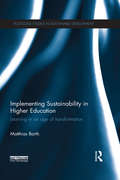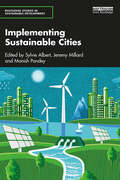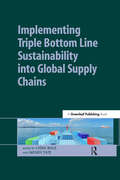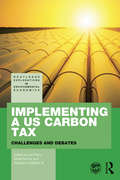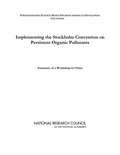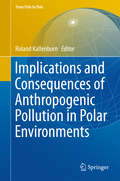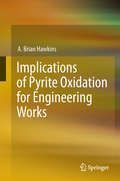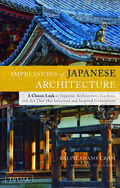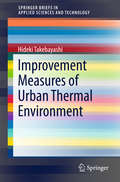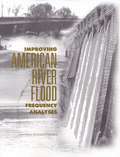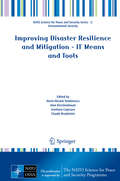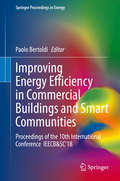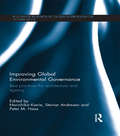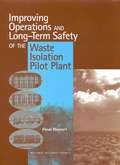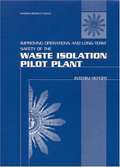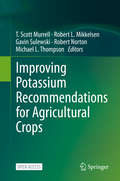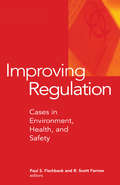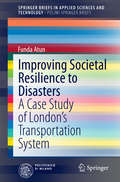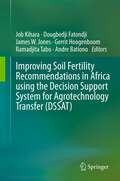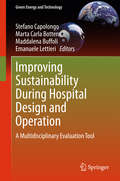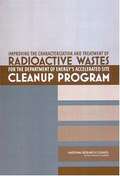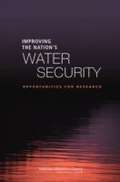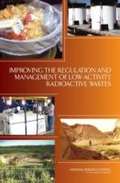- Table View
- List View
Implementing Sustainability in Higher Education: Learning in an age of transformation (Routledge Studies in Sustainable Development)
by Matthias BarthIn a time of unprecedented transformation as society seeks to build a more sustainable future, education plays an increasingly central role in training key agents of change. This book asks how we can equip students and scholars with the capabilities to promote sustainability and how the higher education curriculum can be changed to facilitate the paradigm shift needed. Across the globe, a rising number of higher education institutions and academics are responding to these questions by transforming their own teaching and learning and their institutions’ curricula. This book contributes to that development by examining in-depth case studies of innovative approaches and curriculum changes at multiple levels of the education sector. Elaborating key principles of higher education for sustainable development and identifying drivers and barriers to implementing sustainability in the curriculum, the book provides a comprehensive overview of what makes higher education for sustainable development a unique field of research and practice, as well as offering a coherent narrative of how change can be effected in it. This much-needed book is a valuable resource to inform, guide and inspire students, academics, administrators and community partners, whether experienced or new to the field, whether already committed or not to higher education for sustainable development in an age of transformation.
Implementing Sustainable Cities (Routledge Studies in Sustainable Development)
by Sylvie AlbertThis edited volume brings together international authors to explore how cities around the world are implementing their commitment towards the UN Sustainable Development Goals (SDGs).To achieve sustainability, cities choose their own goals and develop the necessary governance and resourcing mechanisms to achieve their objectives. This book highlights the innovative ways cities can plan their implementation by drawing on comprehensive research and literature reviews. Case studies from around the world, including North and South America, Europe, Asia, and Africa, describe examples of various cities’ governance mechanisms, resourcing strategies, and implementation strategies. By showcasing these case studies, cities worldwide can emulate, transform, and execute their own vision drawing on the examples and pathways laid out by their peers. The book concludes with a comparative analysis of UN SDG implementation, contrasting the approaches and enabling communities worldwide to learn from one another and choose strategies that meet their local needs.This book will be of great interest to students, researchers, and professionals of urban sustainability, planning, smart cities, and sustainable communities. It will also be useful for city and government stakeholders including policy makers, economic development corporations, and non-governmental organizations (NGOs).
Implementing Triple Bottom Line Sustainability into Global Supply Chains
by Lydia Bals Wendy TateThe global sustainability challenge is urgent, tremendous and increasing. From an ecological perspective, the current worldwide resource footprint requires approximately 1.5 planets to sustain existing life, and with current usage would require two planets by 2030. The social impact of ever-growing resource use disproportionately affects the world’s poor – the 3 billion people living on less than $2.50 a day, as they struggle to acquire what is needed to survive. The serious ecological and social challenges we face in trying to establish global sustainable supply chains must not be underestimated, yet so far research has largely ignored the social dimension in favour of the environmental and economic. So how can we develop business strategies that move away from a primary economic focus and give equal weight to people, planet and profit? How can we create sustainable supply chains that take a true triple-bottom-line approach?Implementing Triple Bottom Line Sustainability into Global Supply Chains features innovative research, highlighting new cases, approaches and concepts in how to successfully implement sustainability – covering economic, ecological and social dimensions – into global supply chains. The four parts cover the rationale for sustainable global supply chains, key enablers, case studies showing clear implementation steps, and directions for future research and development.This book is a must-read for any academic researching in sustainable supply chain management, procurement or business strategy, and for business leaders seeking cases that will inform a critical step forward for CSR programmes.
Implementing a US Carbon Tax: Challenges and Debates (Routledge Explorations in Environmental Economics)
by Ian Parry Adele Morris Roberton C. Williams IIIAlthough the future extent and effects of global climate change remain uncertain, the expected damages are not zero, and risks of serious environmental and macroeconomic consequences rise with increasing atmospheric greenhouse gas concentrations. Despite the uncertainties, reducing emissions now makes sense, and a carbon tax is the simplest, most effective, and least costly way to do this. At the same time, a carbon tax would provide substantial new revenues which may be badly needed, given historically high debt-to-GDP levels, pressures on social security and medical budgets, and calls to reform taxes on personal and corporate income. This book is about the practicalities of introducing a carbon tax, set against the broader fiscal context. It consists of thirteen chapters, written by leading experts, covering the full range of issues policymakers would need to understand, such as the revenue potential of a carbon tax, how the tax can be administered, the advantages of carbon taxes over other mitigation instruments and the environmental and macroeconomic impacts of the tax. A carbon tax can work in the United States. This volume shows how, by laying out sound design principles, opportunities for broader policy reforms, and feasible solutions to specific implementation challenges.
Implementing the Stockholm Convention on Persistent Organic Pollutants: Summary of a Workshop in China
by National Research Council of the National AcademiesThis report summarizes a workshop --- Strengthening Science-Based Decision-Making: Implementing the Stockholm Convention on Persistent Organic Pollutants held June 7-10, 2004, in Beijing, China. The presentations and discussions summarized here describe the types of scientific information necessary to make informed decisions to eliminate the production and use of Persistent Organic Pollutants (POPs) banned under the Stockholm Convention, sources of information; scientifically informed strategies for eliminating POPs, elements of good scientific advice, such as transparency, peer review, and disclosure of conflicts of interest; and information dealing with POPs that decision makers need from the scientific community, including next steps to make such science available and ensure its use on a continuing basis.
Implementing the Sustainable Development Goals in Nigeria: Barriers, Prospects and Strategies (Routledge Contemporary Africa)
by Eghosa O. Ekhator Servel Miller Etinosa IgbinosaThis book explores Nigeria’s progress towards achieving the Sustainable Development Goals, presenting key country-specific lessons, as well as providing innovative solutions and practices which are transferrable to other emerging economies. Despite all of Nigeria’s potential, and substantial oil revenues, poverty remains widespread and the country faces many challenges. The contributors to this book provide comparative historical and contemporary analysis of the main challenges for achieving progress in the SDGs, and make recommendations for the most effectives ways of developing, adopting, disseminating and scaling them. Starting with the conceptualisation and evolution of the SDGs, the book goes on to consider the goal on ending poverty, and the urgent need to combat climate change and its impacts. The book also reflects on the role of business and taxation, and the cultural and societal dimensions of the SDGs, including education, gender, and the role of the church. Overall, the book focuses on knowledge/implementation gaps and the role of collaborative partnerships and disruptive technologies in implementing the framework in general. This book will be of interest to scholars, policy makers and practitioners of sustainable development and African studies, as well as those with a particular interest in Nigeria.
Implications and Consequences of Anthropogenic Pollution in Polar Environments
by Roland KallenbornThe first evidence on the adverse effects of organic pollutants on Arctic ecosystems was provided by international research initiatives more than 30 years ago. Today, the indigenous people of the North are considered to be affected by exposure to persistent organic pollutants (POPs) and metals through their traditional marine food sources. The occurrence of pollutants of emerging concern in remote Polar environments is considered an essential criterion for prioritising this (largely neglected) type of contamination in national, international and global regulation schemes. Initiated during the first international Polar Years (IPY 2007-2009) and continued afterwards, 11 representative initiatives and projects are summarised as chapters in this book, which highlights today's interdisciplinary research on POPs in the Polar environment. The individual chapters describe in detail the consequences, priorities and perspectives of international research on POPs (legacy and emerging xenobiotics), its implications for regulations and scientific priorities including societal and cultural developments in the Arctic, as well as conservation priorities in Antarctica. This book is intended for all readers interested in learning more about modern research on environmental pollutants in the Polar environments (with a strong focus on Arctic environments). The impacts of pollution and climate change on Polar regions and the world as a whole will continue to be felt for many years to come. Sound science is, thus, vital in order to underpin actions that need to be taken at the global, regional and local levels. This book contributes to this highly relevant, interdisciplinary environmental scientific endeavour.
Implications of Pyrite Oxidation for Engineering Works
by A. Brian HawkinsThe book highlights and analyses the distress to buildings caused by sulphate-induced heave, with particular reference to the recent problems in the Dublin area of Ireland. It describes the formation of pyrite, the processes involved in its oxidation and the various ways in which consequential expansion takes place. For the first time in the literature it discusses the way that buildings can be raised above their supporting foundation walls by the expansion of pyritiferous fill which has been used beneath ground-bearing floor slabs in Ireland. The significance of fractures through the iron sulphide microcrystals for the rate and extent of oxidation is discussed. Photographs and profiles of sulphate ingress into concrete/concrete blocks are presented. Case histories from the UK, North America and Ireland are discussed.
Impressions of Japanese Architecture
by Mira Locher Ralph Adams Cram"The best book on Japanese architecture ever produced by a Westerner." --The American ArchitectJapanese architecture is undoubtedly less well known and less appreciated than the architecture of any other civilized nation. Not only this, but it is almost universally misjudged, and while the world has by degrees come to know and admire the pictorial and industrial arts of Japan, her architecture, which is the rot and vehicle of all other modes of art, is passed over with a casual reference to its fantastic quality or a patronizing tribute to the excellence of some of its carved decoration.Written at a time when Japanese art was only beginning to be appreciated in the West, Impressions of Japanese Architecture conveys a sense of discovery and enthusiasm that modern readers will find as interesting and infectious as the book's first readers did. Long considered a classic, this new edition contains a foreword by acclaimed contemporary architect and author, Mira Locher. Originally published about one hundred years ago, Impressions of Japanese Architecture is still of immense value to anyone wishing for a better understanding of Japanese architecture, art and culture.
Improvement Measures of Urban Thermal Environment
by Hideki TakebayashiMaximizing readers' insights into urban and architectural environmental planning with consideration for the thermal environment, this work highlights how various urban heat-island strategies have been developed and their effectiveness in urban areas. Specific measures to combat the urban heat-island phenomenon, including improvement of surface cover, reduction of exhaust heat, improvement of ventilation are summarized and various heat-island measurement technologies, which have been proposed in recent years, are organized systematically based on surface- heat budget and surface boundary layer models. With suggestions for the selection of appropriate heat-island technologies depending on the location, this book elucidates the relationship between the thermal environment and urban block form characteristics. Covering the latest research findings, this book is of interest for all those concerned with environmentally friendly urban and architectural planning.
Improving American River Flood Frequency Analyses
by National Research CouncilInformation on Improving American River Flood Frequency Analyses
Improving Disaster Resilience and Mitigation - IT Means and Tools
by Horia-Nicolai Teodorescu Alan Kirschenbaum Svetlana Cojocaru Claude BruderleinThe focus of this volume is comprised of the fundamentals, models, and information technologies (IT) methods and tools for disaster prediction and mitigation. A more detailed list of topics includes mathematical and computational modeling of processes leading to or producing disasters, modeling of disaster effects, IT means for disaster mitigation, including data mining tools, knowledge-based and expert systems for use in disaster circumstances, GIS-based systems for disaster prevention and mitigation and equipment for disaster-prone areas. A specific type or class of disasters (natural or human-made), however will not be part of the main focus of this work. Instead, this book was conceived to offer a comprehensive, integrative view on disasters, seeking to determine what various disasters have in common. Because disaster resilience and mitigation involve humans, societies and cultures, not only technologies and economic models, special attention was paid in this volume to gain a comprehensive view on these issues, as a foundation of the IT tool design.
Improving Energy Efficiency in Commercial Buildings and Smart Communities: Proceedings of the 10th International Conference IEECB&SC’18 (Springer Proceedings in Energy)
by Paolo BertoldiThese proceedings present fourteen peer-reviewed papers from the 10th International Conference on Improving Energy Efficiency in Commercial Buildings and Smart Communities, which was held March 21-22, 2018 in Frankfurt, Germany. This biannual conference aims to promote and diffuse the concept of energy efficiency in new and existing commercial buildings and to enlarge the market for low consumption and sustainable non-residential buildings. It also covers smart and sustainable districts, communities and cities, since energy systems efficiency and renewable energies are often optimized at the district or municipal level. The 2018 conference focused on advanced and innovative technologies to improve the energy efficiency of commercial buildings, communities and cities as well as the policies and measures by governments at various levels to improve energy efficiency. A particular focus was on Energy Service Companies (ESCOs). The conference addresses energy policy makers at international, national, and local level; academics, researchers and energy efficiency experts; ESCOs, utilities, buildings energy and environmental managers; buildings engineers and architects; and equipment manufacturers and commercial property investors.
Improving Global Environmental Governance: Best Practices for Architecture and Agency (Routledge Research in Global Environmental Governance)
by Steinar Andresen Peter M. Haas Norichika KanieThe experience of environmental governance is approached in Improving Global Environmental Governance from the unique perspective of actor configuration and embedded networks of actors, which are areas of emerging importance. The chapters look at existing Multilateral Environmental Agreements (MEAs) and the broader constellation of partially networked institutions to better understand the involvement of individual actors and how to deepen the networks that include them to generate more effective governance. The book covers a wide range of issued pertaining to environmental governance including trans-boundary air pollution, marine pollution, biodiversity and ozone depletion. It also examines partnerships as a hybrid case of emerging modes of environmental governance. These partnerships are a recent form of actor configuration that warrant attention for dealing with global environmental threats in order to better understand the full potential of actor configurations in the absence of state involvement. In order to test applicability to on-going but stalled processes, the book applies the approach to one of the most difficult issues we face: climate change. By addressing key questions in this important area, the book provides new perspectives in the nexus between agency and architecture in environmental governance in the twenty-first century.
Improving Operations AND Long-Term Safety OF THE Waste Isolation Pilot Plant: Final Report
by National Research CouncilThe National Academies Press (NAP)--publisher for the National Academies--publishes more than 200 books a year offering the most authoritative views, definitive information, and groundbreaking recommendations on a wide range of topics in science, engineering, and health. Our books are unique in that they are authored by the nation's leading experts in every scientific field.
Improving Operations And Long-term Safety Of The: Interim Report
by Committee on the Waste Isolation Pilot PlantThe National Academies Press (NAP)--publisher for the National Academies--publishes more than 200 books a year offering the most authoritative views, definitive information, and groundbreaking recommendations on a wide range of topics in science, engineering, and health. Our books are unique in that they are authored by the nation's leading experts in every scientific field.
Improving Potassium Recommendations for Agricultural Crops
by Michael L. Thompson Robert Norton T. Scott Murrell Robert L. Mikkelsen Gavin SulewskiThis open access book highlights concepts discussed at two international conferences that brought together world-renowned scientists to advance the science of potassium (K) recommendations for crops. There was general agreement that the potassium recommendations currently in general use are oversimplified, outdated, and jeopardize soil, plant, and human health. Accordingly, this book puts forward a significantly expanded K cycle that more accurately depicts K inputs, losses and transformations in soils. This new cycle serves as both the conceptual basis for the scientific discussions in this book and a framework upon which to build future improvements. Previously used approaches are critically reviewed and assessed, not only for their relevance to future enhancements, but also for their use as metrics of sustainability. An initial effort is made to link K nutrition in crops and K nutrition in humans. The book offers an invaluable asset for graduate students, educators, industry scientists, data scientists, and advanced agronomists.
Improving Regulation: Cases in Environment, Health, and Safety (Rff Press Ser.)
by Paul S. Fischbeck R. Scott FarrowIs there potential for a U.S. regulatory system that is more efficient and effective? Or is the future likely to involve 'paralysis by analysis'? Improving Regulation considers the challenges faced by the regulatory system as society and technology change, and our knowledge about the effects of our activities on human and planetary health becomes more sophisticated. While considering the difficulty in linking regulatory design and performance, Improving Regulation makes the case for empowering regulatory analysis. Studying applications as diverse as fire protection, air and water pollution, and genetics, its contributors examine the strategies of different stakeholders in today's complex policymaking environment. With a focus on the behavior of institutions and people, they consider the impact that organizational politics, science, technology, and performance have on regulation. They explore the role of technology in creating and reducing uncertainty, the costs of control, the potential involvement of previously unregulated sectors, and the contentious public debates about fairness and participation in regulatory policy. Arguing that the success of many regulations depends upon their acceptance by the public, Fischbeck, Farrow, and their contributors offer extensive, inductive evidence on the art of regulatory analysis. The resulting book provides 'real world' examples of regulation, and a demonstration of how to synthesize analytical skills with a knowledge of physical and social processes.
Improving Societal Resilience to Disasters
by Funda AtunThis book documents the outcomes of a study designed to explore ways of increasing resilience in a complex city system against disasters by focusing on the transportation system in London. A survey was undertaken comprising interviews with upper level decision makers as well as questionnaires to personnel in the field and the general public. The results of this survey are presented, together with a brief description of the past and current situation in the city with respect to transportation, flood risk and other vulnerabilities. The sources of problems in responding adequately to disasters are analyzed and important lessons drawn. In particular, it is explained how failures derive from insistence upon the application of written plans in preference over redefinition of strategies and priorities and how flexible systems represent a better approach to crisis situations. The book will be of interest to all who are concerned with disaster planning and management and the societal response to disasters.
Improving Soil Fertility Recommendations in Africa using the Decision Support System for Agrotechnology Transfer (DSSAT)
by Andre Bationo Job Kihara Gerrit Hoogenboom Ramadjita Tabo Dougbedji Fatondji James W JonesThe book gives a detailed description of the application of DSSAT in simulating crop and soil processes within various Agro-ecological zones in Africa. The book, an output of a series of 3 workshops, provides examples of the application of DSSAT models to simulate nitrogen applications, soil and water conservation practices including effects of zai technology, phosphorus and maize productivity, generation of genetic coefficients, long-term soil fertility management technologies in the drylands, microdosing, optimization of nitrogen x germplasms x water, spatial analysis of water and nutrient use efficiencies and, tradeoff analysis. The minimum dataset requirements for DSSAT is discussed. This book arises from attempts to address the limited use of models in decision support by African agricultural (both soil scientist and agronomists) scientists.
Improving Sustainability During Hospital Design and Operation
by Stefano Capolongo Marta Carla Bottero Maddalena Buffoli Emanuele LettieriThis book describes the Sustainable High Quality Healthcare (SustHealth) project, which had the goal of developing an original multidisciplinary evaluation tool that can be applied to assess and improve hospitals' overall sustainability. The comprehensive nature of the appraisal offered by this tool exceeds the scope of most current rating systems, which typically permit a thorough evaluation of relevant environmental factors when designing a new building but fail to consider social and economic impacts of the design phase or the performance of the hospital's operational structure in these fields. The multidisciplinary evaluation system was developed, from its very inception through to its testing, by following a scientific experimental method in which a global perspective was constantly maintained, as opposed to a focus only on specific technical issues. Application of the SustHealth rating tool to a currently functioning hospital, or one under design, will identify weaknesses and guide users to potential low-cost short-term solutions and longer-term strategies for improvement.
Improving The Characterization And Treatment Of Radioactive Wastes For The Department Of Energy's Accelerated Site Cleanup Program
by National Research Council of the National AcademiesThe Department of Energy’s Office of Environmental Management (EM) directs the massive cleanup of more than 100 sites that were involved in the production of nuclear weapons materials during the Manhattan Project and the Cold War. This report offers suggestions for more effectively characterizing and treating the orphan and special-case wastes that are part of EM’s accelerated cleanup program. It identifies technical opportunities for EM to improve the program that will save time and money without compromising health and safety. The opportunities identified include: making more effective use of existing facilities and capabilities for waste characterization, treatment, or disposal; eliminating self-imposed requirements that have no clear technical or safety basis; and investing in new technologies to improve existing treatment and characterization capabilities. For example, the report suggests that EM work with DOE classification officers to declassify, to the extent possible, classified materials declared as wastes. The report also suggests a new approach for treating the wastes that EM will leave in place after cleanup.
Improving The Nation's Water Security: Opportunities For Research
by National Research Council of the National AcademiesConcern over terrorist attacks since 2001 has directed attention to potential vulnerabilities of the nation’s water and wastewater systems. The Environmental Protection Agency (EPA), which leads federal efforts to protect the water sector, initiated a research program in 2002 to address immediate research and technical support needs. This report, conducted at EPA’s request, evaluates research progress and provides a long-term vision for EPA’s research program. The report recommends that EPA develop a strategic research plan, address gaps in expertise among EPA program managers and researchers, and improve its approaches to information dissemination. The report recommends several high-priority research topics for EPA, including conducting empirical research in behavioral science to better understand how to prepare people for water security incidents.
Improving The Regulation And Management Of Low-activity Radioactive Wastes
by National Research Council of the National AcademiesThe largest volumes of radioactive wastes in the United States contain only small amounts of radioactive material. These low-activity radioactive wastes (LAW) should be regulated and managed according to the degree of risk they pose for treatment, storage, and disposal. Current regulations are based primarily on the type of industry that produced the waste-the waste's origin-rather than its risk. In this report a risk-informed approach for regulating and managing all types of LAW in the United States is proposed. Implemented in a gradual or stepwise fashion, this approach combines scientific risk assessment with public values and perceptions. It focuses on the hazardous properties of the waste in question and how they compare with other waste materials. The approach is based on established principles for risk-informed decision making, current risk-informed initiatives by waste regulators in the United States and abroad, solutions available under current regulatory authorities, and remedies through new legislation when necessary.
Improving The Scientific Basis For Managing Doe's Excess Nuclear Materials And Spent Nuclear Fuel
by Committee on Improving the Scientific Basis for Managing Nuclear Materials Spent Nuclear Fuel through the Environmental Management Science ProgramThis study identifies research opportunities for storage, recycle, reuse, or disposal of nuclear materials and spent nuclear fuel. Most of the materials dealt with in this report have not been declared as waste. The report completes the fifth in a series of studies requested by the EMSP to assist in developing its calls for proposals and evaluating proposals on this issue. There is no subject index. Annotation ©2004 Book News, Inc. , Portland, OR (booknews. com)
